In this article we’ll be discussing the FMS and how it gives us information to design programs for you to keep you from getting hurt and fixing hidden weakness or imbalances.
Go Here for Part 1
The Functional Movement Screen:
The Functional Movement Screen or FMS, looks at 7 different movement patterns and assigns a number from 0 (can’t do) to 3 (perfect) to each screen. It’s not important to be all 3’s. It IS important to be over 14 total and even more important to have the same score on each side on unilateral movements. We also test for pain on some movements, any pain scores a zero and we ask you to see a doc. This is NOT a test, there is no pass / fail.
Movement 1- The Overhead squat. 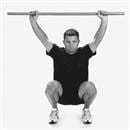 How well you squat, how tight you are in the ankles, back and shoulders. Do you have a weight shift to the side and whether your knee(s) collapse and several other things. A score of three would be feet flat on floor, pointed straight ahead, no knee collapse, neutral spine, vertical spine and arms vertical. A 0 means you can’t do the movement. A 2 is not being vertical or the arms coming forward a little. A 1 is foot position off, knee collapse, upper body angle not matching shin angle.
How well you squat, how tight you are in the ankles, back and shoulders. Do you have a weight shift to the side and whether your knee(s) collapse and several other things. A score of three would be feet flat on floor, pointed straight ahead, no knee collapse, neutral spine, vertical spine and arms vertical. A 0 means you can’t do the movement. A 2 is not being vertical or the arms coming forward a little. A 1 is foot position off, knee collapse, upper body angle not matching shin angle.
Movement 2 – The Hurdle step. 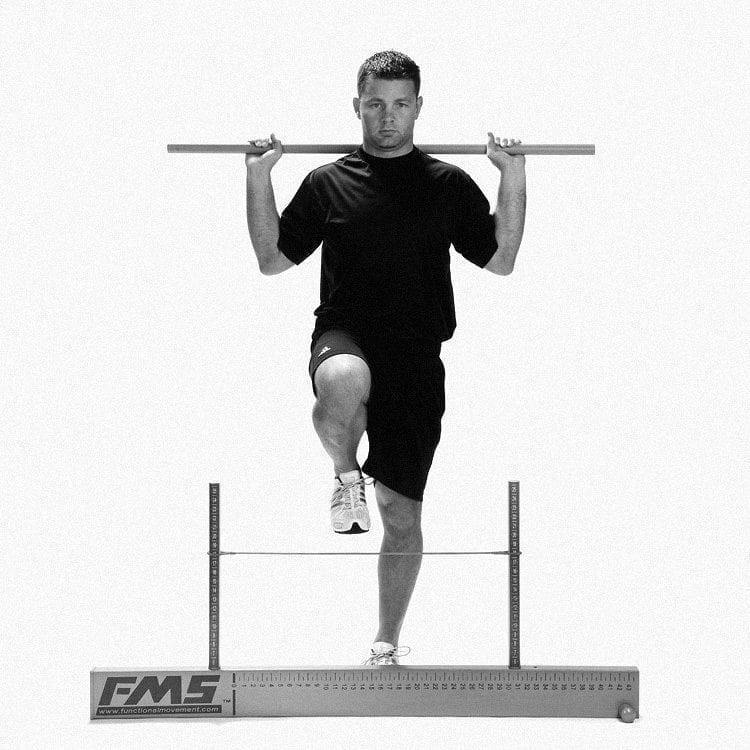 You step over a barrier set to the height of your shin and we look for balance problems, torso movement or knocking over the barrier. If you have one side better than the other it’s something we need to focus on in your program design. A 3 means there was no movement in the upper or lower body except the hip. The knee didn’t swing out or under. A 2 means there might have been some upper body movement, the knee turned out or the foot came under. A 1 typically is extraneous movement in upper & lower body and is usually accompanied by poor balance. A 0 means you either couldn’t do the screen or you kicked it over. You could have a 3 on one side and a 1 on the other which means you have an asymmetry somewhere that needs to be address.
You step over a barrier set to the height of your shin and we look for balance problems, torso movement or knocking over the barrier. If you have one side better than the other it’s something we need to focus on in your program design. A 3 means there was no movement in the upper or lower body except the hip. The knee didn’t swing out or under. A 2 means there might have been some upper body movement, the knee turned out or the foot came under. A 1 typically is extraneous movement in upper & lower body and is usually accompanied by poor balance. A 0 means you either couldn’t do the screen or you kicked it over. You could have a 3 on one side and a 1 on the other which means you have an asymmetry somewhere that needs to be address.
Movement 3 – Lunge pattern. 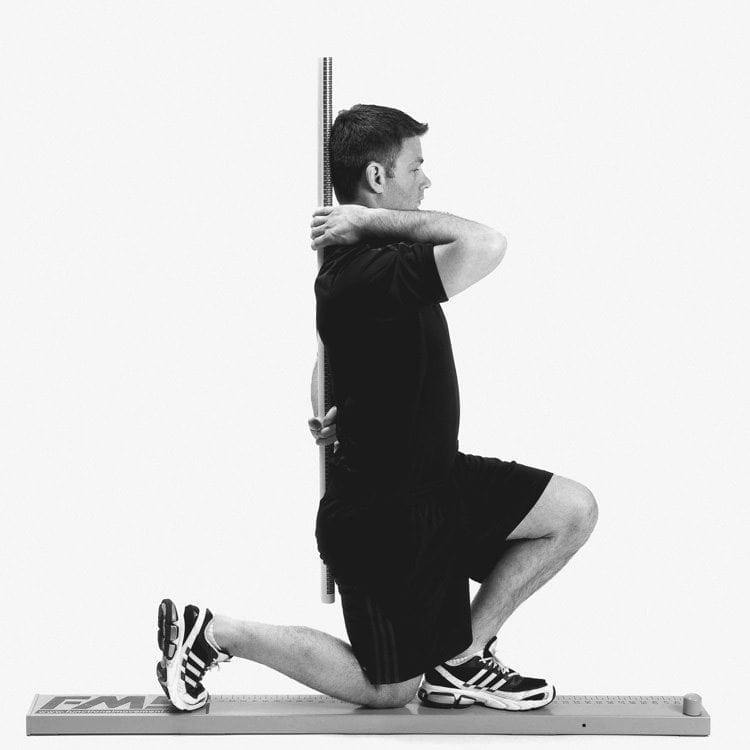 You are on a very narrow base of support and the feet are separated by the length of your shin. We are looking for balance, being able to touch the knee to the floor and what happens in the torso. Again having one side better than the other is a red flag. A 0 means you fell off the board a 3 means you look like the picture to the left. A 1 or 2 are various degrees of not being a 3. There’s a correlation between the Inline Lunge & the Hurdle step and if you are asymmetrical on one screen you will probably be asymmetrical on the other.
You are on a very narrow base of support and the feet are separated by the length of your shin. We are looking for balance, being able to touch the knee to the floor and what happens in the torso. Again having one side better than the other is a red flag. A 0 means you fell off the board a 3 means you look like the picture to the left. A 1 or 2 are various degrees of not being a 3. There’s a correlation between the Inline Lunge & the Hurdle step and if you are asymmetrical on one screen you will probably be asymmetrical on the other.
Movement 4 – Shoulder mobility. 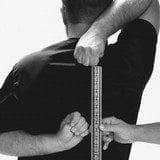 How close together can you bring your hands behind your back. One hand goes over the top of the shoulder, the other comes from underneath. We are looking at the distance between fists. Once we complete that we screen we check for pain in the movement. Pain means a 0 score and we ask you to see your doc. If you can get your fists within a hand span (the distance between the tip of you pinky & tip of the thumb) you score a 3. 1.5 – 2x the hand span is a 2, anything further apart than that is a 1.
How close together can you bring your hands behind your back. One hand goes over the top of the shoulder, the other comes from underneath. We are looking at the distance between fists. Once we complete that we screen we check for pain in the movement. Pain means a 0 score and we ask you to see your doc. If you can get your fists within a hand span (the distance between the tip of you pinky & tip of the thumb) you score a 3. 1.5 – 2x the hand span is a 2, anything further apart than that is a 1.
Test 5 – Active Straight Leg Raise. 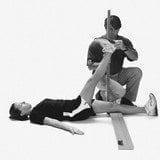 You lie on your back, legs out straight and raise one up as far as you can. We look for how far up it goes without the knee bending and with no movement in the low back, the other hip or foot. A 3 is the ability to raise the leg straight up to 90 degree or more, no hip movement, no back movement, the knee stays straight and the other leg doesn’t move rotate. A 0 means you couldn’t get to at least 70 degrees. It’s important to not this is not about hamstring flexibility! We are looking for core control and stabilization and where you get your movement from.
You lie on your back, legs out straight and raise one up as far as you can. We look for how far up it goes without the knee bending and with no movement in the low back, the other hip or foot. A 3 is the ability to raise the leg straight up to 90 degree or more, no hip movement, no back movement, the knee stays straight and the other leg doesn’t move rotate. A 0 means you couldn’t get to at least 70 degrees. It’s important to not this is not about hamstring flexibility! We are looking for core control and stabilization and where you get your movement from.
Test 6 – the Pushup test. 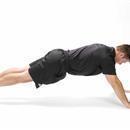 The is test forces you to do the pushup in an extended position and from the floor up which requires more strength and core stability than a standard pushup. We’re looking to see if your body moves as a unit or in segments, which can indicate a weak core. We also check for back pain on this screen. A 3 means you executed the pushup correctly, the entire body moving as a unit, staying rigid (a pushup is a plank). A 0 means you couldn’t do (no knees allowed) or there was pain. A 2 means you moved the hands a little closer to the shoulders and could do it correctly
The is test forces you to do the pushup in an extended position and from the floor up which requires more strength and core stability than a standard pushup. We’re looking to see if your body moves as a unit or in segments, which can indicate a weak core. We also check for back pain on this screen. A 3 means you executed the pushup correctly, the entire body moving as a unit, staying rigid (a pushup is a plank). A 0 means you couldn’t do (no knees allowed) or there was pain. A 2 means you moved the hands a little closer to the shoulders and could do it correctly
Test 7 – Rotary Stability. 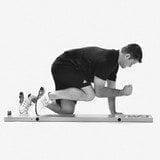 Can you extend an arm and leg without falling over then bring the elbow and knee together in your centerline? If you’ll notice in the picture the guy is touching his R elbow & R knee and maintaining perfect alignment; that’s a 3. It is very hard as some of you know. If you can’t do that you’ll do a bird dog like movement raising one arm in front and the opposite leg back, then try to bring the elbow and knee together centerline. This screen is for core control and stability as well as hip and glute function. There is a pain screen on this one too.
Can you extend an arm and leg without falling over then bring the elbow and knee together in your centerline? If you’ll notice in the picture the guy is touching his R elbow & R knee and maintaining perfect alignment; that’s a 3. It is very hard as some of you know. If you can’t do that you’ll do a bird dog like movement raising one arm in front and the opposite leg back, then try to bring the elbow and knee together centerline. This screen is for core control and stability as well as hip and glute function. There is a pain screen on this one too.
Once you done all seven screens we look at your numbers and focus on the ones that were different right to left and address those first. After we get those cleaned up (which could take a month or more) we may have you re-take the FMS to see what has changed after the focus on the asymmetry. If you had no asymmetries we’ll work on the lowest score next. For example, you had a 2/2 on the Rotary stability and everything else was a 3 we’d create a program to help strengthen your core, internal and external obliques and other muscles that come into play. We aren’t trying to correct you to score well on the FMS we are trying to strengthen you for life!
How we address the asymmetries or low scores varies and can be anything from foam rolling the area to 1 leg deadlifts to strengthen the glutes to stretching. Some people consider the movements correctives but that can be a negative connotation to some. Most exercises can be corrective, it’s how they are performed. A deadlift can be corrective if done slowly with proper emphasis on core, glutes and driving through. A band pull can be for conditioning if done fast as possible or can be corrective if slowed down and a static hold is put in. Dynamic movements like the clean or snatch are not correctives because you can’t control the tempo of the movement: you can’t do a snatch slowly! The swing however can be because it’s actually a progression from the Sumo DL. Once you can perform the sumo DL properly and your core glutes, etc are working properly move to the swing to work on dynamic stabilization patterns.
In our programs I try to put “corrective” exercises throughout the workout. You’ll do some during the activation and mobilizations portions and others during the main portion of the workout. This serves several functions; they can be used as active recovery between other more demanding exercises, they can be done to assist other movements or can be used as a warmup circuit (a Band series) or cooldowns (farmer’s walks or overhead walks).
The FMS tells a lot about underlying problems of which you may not be aware. We address those issues in your training program by having you do certain exercises designed to correct them. This will also help prevent injuries. We also make sure you aren’t doing exercises that will make things worse! If you can’t lit your arm over your head without arching the back you shouldn’t do presses, push presses, snatch or jerks until whatever is causing the back to arch is cleared up. We may have you do a 1/2 kneeling press or tall kneeling press with a light weight because it forces you to recruit the abs and glutes more which will help stabilize the spine.
Even with all the information we get from the FMS and the Postural Analysis we still may not have the full picture. We see the issues, we know there’s an imbalance and we program for it but after a month to 6 weeks we see no change. That’s when the Full Assessment should be done. It allows us to drill down to specific muscles or joints that are the underlying cause of your pain or imbalance.
In our next segment we’ll discuss the Full Assessment and how it can give us much more information on what you need to train without injury or pain and to fix underlying issues.

